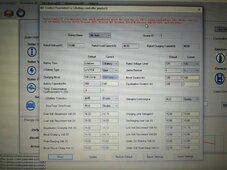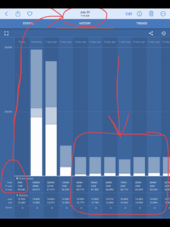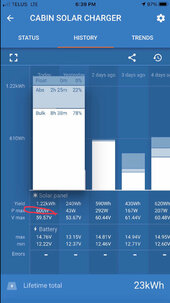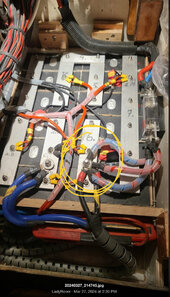PARTS
3x Trina Solar Vertex S 400w Panel
1x Rutland 1200 Wind generator
3x Epever Tracer 4210 AN MPPT 40A
1x Waeco Perfectcharge MCA 1250 50A
1x Daly 400Amp (non smart) BMS
1x 840Ah LiFePo4 12V battery pack, build with 12x 3.2V cells
1x Lead acid 12V starter battery
1x Flamezum 2000W/4000W True sine inverter
DESCRIPTION
System was working fine but got disassembled at ¾ charge status and reassembled after 3 month shipyard visit.
Cells were measured before reassembly and all measured 3.2V.
System was completely discharged to set capacity measure to zero.
Than charged with Waeco at dock until no more change in Voltage.
Then charge capacity set as 100%.
Now afloat without external charge sources except wind, solar and if need be generator.
Lead acid battery is only connected to Rutland turbine and engines via exit 1.
Rutland exit 2 is connected to LiFePo4 charge busbar.
PROBLEM
Charge indicator says 60.8% full, 12.98V.
When 1200W kettle is run from inverter, voltage drops rapidly. This never happened before dissassembley.
Solar panels show 38V but deliver only 0.5-2 Amps each at charge exit of Epever.
Epever settings are the same as the ones used for 2years before disassembley.
When charging via Waeco with generator about 25A go in.
We never let the Waeco on over extended periods. It is just used to charge to about 80%. No float charging with it as we aware that LiFePo4 don't like that.
All charge sources are turned off manually when battery charge is at about 80-85%.
QUESTIONS
Why does the LiFePo4 battery not take in the Solar Power?
Why does the voltage drop now when we start the kettle, we used to be able to cook dinner easily with a 2000W hot plate.
How can we fix the above?
3x Trina Solar Vertex S 400w Panel
1x Rutland 1200 Wind generator
3x Epever Tracer 4210 AN MPPT 40A
1x Waeco Perfectcharge MCA 1250 50A
1x Daly 400Amp (non smart) BMS
1x 840Ah LiFePo4 12V battery pack, build with 12x 3.2V cells
1x Lead acid 12V starter battery
1x Flamezum 2000W/4000W True sine inverter
DESCRIPTION
System was working fine but got disassembled at ¾ charge status and reassembled after 3 month shipyard visit.
Cells were measured before reassembly and all measured 3.2V.
System was completely discharged to set capacity measure to zero.
Than charged with Waeco at dock until no more change in Voltage.
Then charge capacity set as 100%.
Now afloat without external charge sources except wind, solar and if need be generator.
Lead acid battery is only connected to Rutland turbine and engines via exit 1.
Rutland exit 2 is connected to LiFePo4 charge busbar.
PROBLEM
Charge indicator says 60.8% full, 12.98V.
When 1200W kettle is run from inverter, voltage drops rapidly. This never happened before dissassembley.
Solar panels show 38V but deliver only 0.5-2 Amps each at charge exit of Epever.
Epever settings are the same as the ones used for 2years before disassembley.
When charging via Waeco with generator about 25A go in.
We never let the Waeco on over extended periods. It is just used to charge to about 80%. No float charging with it as we aware that LiFePo4 don't like that.
All charge sources are turned off manually when battery charge is at about 80-85%.
QUESTIONS
Why does the LiFePo4 battery not take in the Solar Power?
Why does the voltage drop now when we start the kettle, we used to be able to cook dinner easily with a 2000W hot plate.
How can we fix the above?









